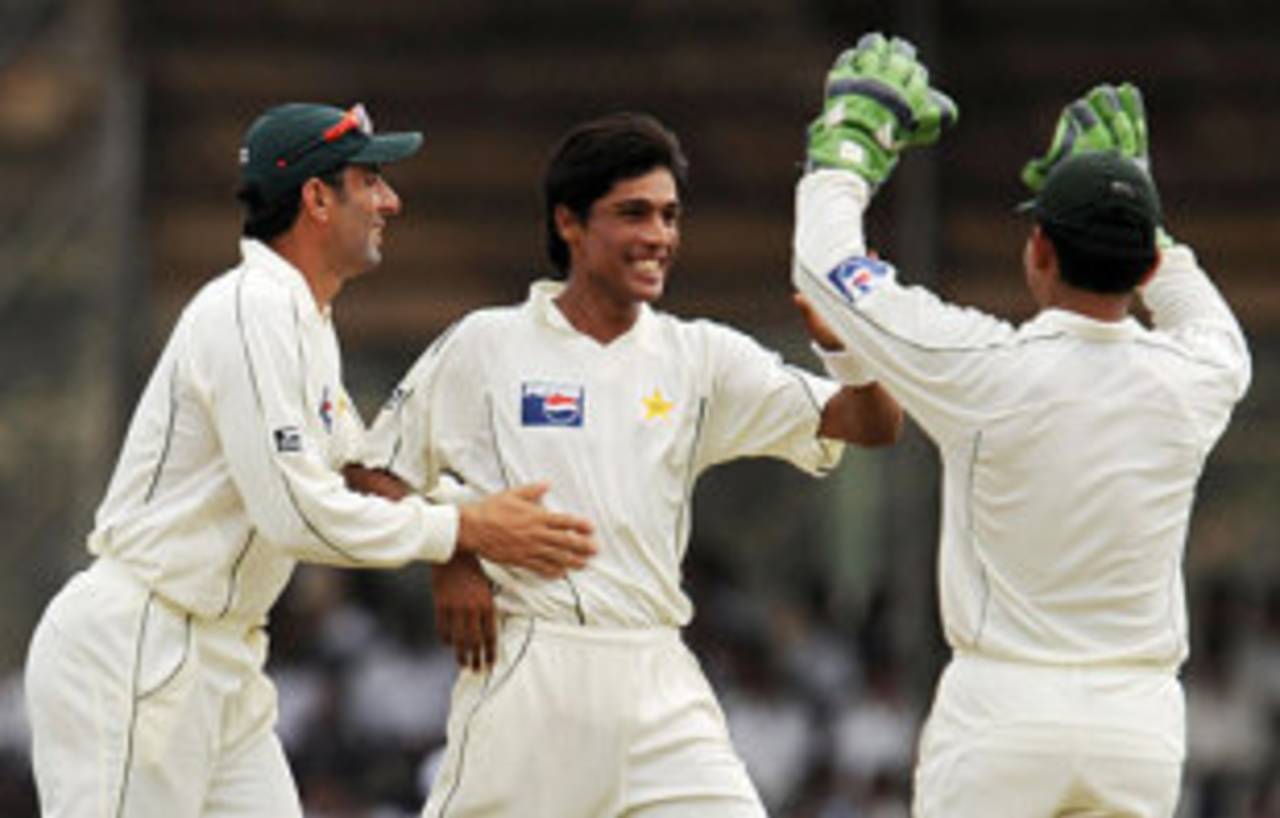The un-Pakistani quicks
A 17-year old who came through the Lahore academy and a 30-year old who took nearly 450 first-class wickets before he could make his Test debut
Sidharth Monga in Galle
04-Jul-2009

Mohammad Aamer is a protégé of Wasim Akram • AFP
Whenever a young Pakistan fast bowler comes up and surprises the world - actually the world ought to be prepared by now - one story, perhaps an urban legend, comes to mind. Here goes. In the October of 1989 Imran Khan was down with viral fever, and resting at his Lahore home. On the TV he saw a young unknown fast bowler bowling for United Bank Limited against Delhi in the Super Wills Cup, an annual fixture then between the Quaid-e-Azam champions and Ranji Trophy champions.
Imran jumped out of the bed, drove down to the venue, and made sure the youngster was picked for the upcoming Sharjah tour. Eight days later the 17-year-old Waqar Younis opened the bowling with Wasim Akram in Sharjah, against West Indies.
Such sudden emergence of fast bowlers adds to the mystique around the art they practise, especially since the very fact that they take bagfuls of wickets on pitches that don't assist them is beyond the immediate understanding of many. That's how every fast bowler is supposed to come up in Pakistan, right? Wrong. The times, they are a-changing.
With Mohammad Aamer, all of 17, taking wickets in the first over of both his international debuts, it is easy to think 'there comes another young Pakistan pace man picked from tape-ball cricket'. Aamer, though, has been a name going around for the last year and a half at least. Be thanked, the pace-bowling camps at the National Cricket Academy in Lahore, where former bowlers Akram, Waqar and Aaqib Javed identify the talent, and make sure it is nurtured.
Aamer, after taking three wickets on Test debut, spoke of influences on his cricket. "Mere cricket mein nikhar laya Wasim Akram ne," he said in Urdu. It's a sentiment that will get lost in translation, the closest being: "Wasim Akram nurtured my cricket." That process of bringing nikhar started two years ago, at one of those camps. Last year, during the Asia Cup, Akram told Cricinfo he would immediately select Aamer for the national team.
The academy in Lahore tries to provide that sort of structure to fast bowling, where raw talent is spotted, given technical and psychological guidance for about two years before players make their debuts. "Apart from the help that we have got in our actual bowling through Aaqib bhai, Wasim bhai, and Waqar bhai, we have at least two to three trainers at our disposal at any given time. They help us understand our body better," Aamer said.
That takes the romance out, doesn't it? The method is developed on. But then let's be realistic. Akram and Waqar, so gloriously unsullied by coaching, always had Imran and each other to learn from. He might not have had one, but Akram will never say he didn't want a coach. However possible mentors for the new generation have been busy meeting with lawyers and judges.
Also, the presence of Shoaib Akhtar and Mohammad Asif in the Pakistan side meant Abdur Rauf, a domestic giant with a huge fan following in Pakistan, had to wait until he was 30 to cock his wrist and land the ball on the seam in a Test match. When did we last see a 30-year-old debutant from Pakistan anyway?
Rauf might not have the pace now, but he showed he could get the bounce and the movement, and also serve as a foil for the lead bowlers. Needless to say, Rauf has come through the ranks before playing for Pakistan. He has played at Under-17, Under-19, club, first-class and Pakistan A levels before he could play for Pakistan. "You could say I've really had to pay my dues in order to get where I am today," he told Pakpassion.net last year. He indeed has paid his dues, seen some deserving fast bowlers get injured and lose out, got injured himself, faced the disappointment of making in to the XVs, the A sides, and still not getting the Pakistan cap.

It's rare for a Pakistan fast bowler to make his debut at 30•Associated Press
Not many in Pakistan and India, given the set-ups, make debuts after having taken close to 450 first-class wickets. Amit Mishra from India is one who had taken more than 300 wickets in first-class cricket when he debuted in Mohali last year. In these necks of the woods, by such time, you ought to have resigned yourself to domestic cricket. It is difficult to be mentally prepared for debuts at 30. Especially if you are a Pakistan fast bowler.
Rauf has managed that, and he could get at least three Tests (because Pakistan have only three pace bowlers in the XV, and because Younis Khan shows an inclination to play three) to make the impact he has waited to make for the last 10 years. And he will need three, because he is not the kind of bowler for sudden impact. He is more like Stuart Clark than Brett Lee.
This current line-up, so boldly selected, could truly be a landmark ensemble for Pakistan. The leader of the pack, only 18 Tests old so perhaps not a mentor, Umar Gul, has so wonderfully escaped the glamour that has become both the right and the bane of a modern Pakistan fast bowler. All three defy the set image of a Pakistan fast bowler, all three add to the richness.
Sidharth Monga is a staff writer at Cricinfo